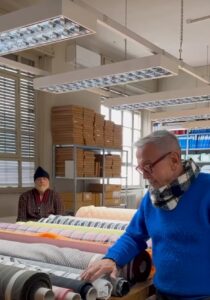That of Luigi Bianchi, founder of the famous men’s fashion house Lubiam, can be considered the classic success story that began with a small dream, but strong enough to lead him to cross the borders of his small village in the province of Mantua to achieve something great.
So at the age of 16, Luigi Bianchi moved to the city of Turin to study tailoring. An art that is not entirely new to him, since his father, and his father before him, also practice this job in the family.
In 1911 the dream came true, with the inauguration of Primaria Sartoria Luigi Bianchi, specialized in the creation of suits for men and suits for women. A success that goes even further beyond the borders of Italy, establishing itself as Made in Italy excellence.
Over time, the size of the business also underwent a change, going from a family-run shop to a large company with more than 300 employees. This also happens thanks to the desire of Edgardo Bianchi, Luigi’s son, to adopt a Fordist approach within the company, aimed at improving and speeding up production processes.

Bruno Barbieri visits Lubiam factory in Mantua
In 1936, the company took the name of Industria Confezioni Luigi Bianchi, which three years later changed again to the current Lubiam, an acronym for Luigi Bianchi Mantova.
After the Second World War, success continued and Lubiam expanded not only in Europe, but also in the USA, China and Japan.
With their history and values linked to the family, Lubiam is focused on a style characterized by elegance and good taste typical of the Italian tradition, but without giving up innovation and experimentation.
His garments dress celebrities too, for example Elio when he was judge in the TV show X-Factor, or Bruno Barbieri and Antonio Cannavacciuolo in Masterchef, or Alessandro Borghese in 4 Ristoranti.
GLS busbars for the Lubiam headquarters in Mantua
Lubiam has maintained its headquarters in Mantua, as we said, the birthplace of its founder, where it all began. More precisely, the factory is located in Valletta Paiolo.
It’s here that our company supplied the GLS busbars for the electricity distribution in the factory.
GLS, in fact, is our specific line for lighting, especially in the industrial sector, but it is also ideal for installation in hospitals, underground car parks, hypermarkets, warehouses and generally in very spacious environments.
Its strong point is the “minimal” factor: minimal dimensions, lightness, minimal installation times (and with great ease) and minimal installation costs, also thanks to the flexibility we find in its tap off boxes, which can be removed or moved according to needs.
It owns an IP55 protection which makes it particularly resistant to humidity. It is also recyclable and reusable thanks to the materials that compose it, aluminum on the outside and copper conductors on the inside.
Graziadio. Yes, We Busbar